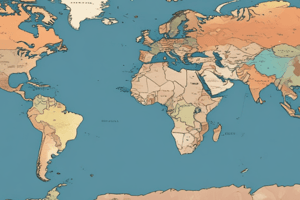Podcast
Questions and Answers
What is the aim of Russia's invasion of Ukraine in February 2022?
What is the aim of Russia's invasion of Ukraine in February 2022?
- To topple the Western-aligned government of Volodymyr Zelenskyy (correct)
- To restore Russia to its former power and prestige
- To expand NATO
- To deter Ukrainian democracy
What term did Putin use to refer to the area of southeastern Ukraine?
What term did Putin use to refer to the area of southeastern Ukraine?
- Euromaidan
- New Russia (correct)
- Donbas
- Kharkiv
What event in 2013 triggered countrywide protests in Ukraine?
What event in 2013 triggered countrywide protests in Ukraine?
- The Cold War
- The invasion of Crimea
- The scrapping of plans to formalize a closer economic relationship with the EU (correct)
- The deposing of President Yanukovych
What did the US, UK, and Russia pledge to Ukraine in 1994?
What did the US, UK, and Russia pledge to Ukraine in 1994?
What was the result of Ukraine's counteroffensive against Russian forces in late August 2021?
What was the result of Ukraine's counteroffensive against Russian forces in late August 2021?
Flashcards are hidden until you start studying
Study Notes
-
Ukraine has been a key player in the global security order for decades, playing a role in the Cold War between the US and the Soviet Union.
-
In February 2022, Russia invaded Ukraine with the aim of toppling the Western-aligned government of Volodymyr Zelenskyy.
-
The hostilities in the Donbas have left more than fourteen thousand people dead.
-
Russia's seizure of Crimea and its support for separatists in the Donbas has shifted the global security environment from a unipolar period of U.S. dominance to one defined by renewed competition between great powers.
-
In 2013, President Yanukovych, acting under pressure from his supporters in Moscow, scrapped plans to formalize a closer economic relationship with the EU.
-
This triggered countrywide protests known as Euromaidan.
-
Putin framed the ensuing tumult of Euromaidan, which forced Yanukovych from power, as a Western-backed “fascist coup” that endangered the ethnic Russian majority in Crimea.
-
In response, Putin ordered a covert invasion of Crimea that he later justified as a rescue operation.
-
Putin employed a similar narrative to justify his support for separatists in southeastern Ukraine, another region home to large numbers of ethnic Russians and Russian speakers.
-
He famously referred to the area as Novorossiya (New Russia), a term dating back to eighteenth-century imperial Russia.
-
Armed Russian provocateurs, including some agents of Russian security services, are believed to have played a role in the conflict in eastern Ukraine.
-
In 2022, Russia invaded Ukraine in response to NATO's expansion into the former Soviet bloc and demands that the United States and NATO cease expanding the alliance.
-
Russia's objectives in Ukraine include restoring Russia to its former power and prestige and deterring Ukrainian democracy.
-
In July 2021, Putin authored what many Western foreign policy experts viewed as an ominous article explaining his controversial views of the shared history between Russia and Ukraine. Among other remarks, Putin described Russians and Ukrainians as “one people” who effectively occupy “the same historical and spiritual space.”
-
In February 2022, Putin ordered a full-scale invasion, crossing a force of some two hundred thousand troops into Ukrainian territory from the south (Crimea), east (Russia), and north (Belarus), in an attempt to seize major cities, including the capital Kyiv, and depose the government. However, in the early weeks of the invasion, Ukrainian forces marshaled a stalwart resistance that succeeded in bogging down the Russian military in many areas, including in Kyiv.
-
Many defense analysts say that Russian forces have suffered from low morale, poor logistics, and an ill-conceived military strategy that assumed Ukraine would fall quickly and easily. In late August, Ukraine launched a major counteroffensive against Russian forces, recapturing thousands of square miles of territory in the Kharkiv and Kherson regions. The campaigns marked a stunning setback for Russia.
-
Amid the Russian retreat, Putin ordered the mobilization of some three hundred thousand more troops, illegally annexed four more Ukrainian regions, and threatened to use nuclear weapons to defend Russia’s “territorial integrity.” Most security analysts see little chance for diplomacy in the months ahead, as both sides have strong motives to continue the fight.
-
In 1994, the United States, the United Kingdom, and Russia pledged via the Budapest Referendum to respect Ukraine’s independence and sovereignty in return for it becoming a nonnuclear state. Twenty years later, as Russian forces seized Crimea, restoring and strengthening Ukraine’s sovereignty became a top priority for the United States.
Studying That Suits You
Use AI to generate personalized quizzes and flashcards to suit your learning preferences.





